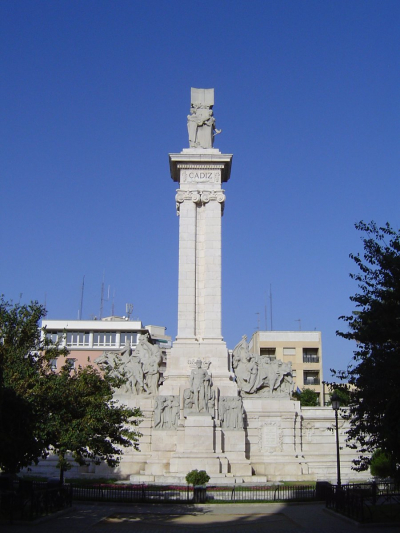The Political Constitution of the Spanish Monarchy (Spanish: Constitucin Poltica de la Monarqua Espaola), also known as the Constitution of Cdiz (Spanish: Constitucin de Cdiz) and as La Pepa, was the first Constitution of Spain and one of the earliest codified constitutions in world history. The Constitution was ratified on 19 March 1812 by the Cortes of Cdiz, the first Spanish legislature that included delegates from the entire nation, including Spanish America and the Philippines. "It defined Spanish and Spanish American liberalism for the early 19th century."With the notable exception of proclaiming Roman Catholicism as the official and sole legal religion in Spain, the constitution was one of the most liberal of its time: it affirmed national sovereignty, separation of powers, freedom of the press, free enterprise, abolished corporate privileges (fueros), and established a constitutional monarchy with a parliamentary system. It was one of the first constitutions that allowed universal male suffrage, with some exceptions, through a complex indirect electoral system. It extended political rights for representation to Spanish America and the Philippines, a significant step for the demands of American-born Spaniards.When King Ferdinand VII returned to power in 1814, he dissolved the Cortes and abrogated the constitution, re-establishing absolute monarchy. The constitution was reinstated during the Trienio Liberal (18201823) and again in 18361837 while the Progressives prepared the Constitution of 1837. It was an important model for later constitutions in Spain and Spanish America.
The Cortes of Cádiz was a revival of the traditional cortes (Spanish parliament), which as an institution had not functioned for many years, but it met as a single body, rather than divided into estates as with previous ones.The General and Extraordinary Cortes that met in the port of Cádiz starting 24 September 1810 "claimed legitimacy as the sole representative of Spanish sovereignty", following the French invasion and occupation of Spain during the Napoleonic Wars and the abdication of the monarch Ferdinand VII and his father Charles IV. It met as one body, and its members represented the entire Spanish Empire, that is, not only Spain but also Spanish America and the Philippines.The Cortes of Cádiz was seen then, and by historians today, as a major step towards liberalism and democracy in the history of Spain and Spanish America. The liberal Cortes drafted and ratified the Spanish Constitution of 1812, which established a constitutional monarchy and eliminated many institutions that privileged some groups over others.

1812Mar, 19
The Cádiz Cortes promulgates the Spanish Constitution of 1812.
Choose Another Date
Events on 1812
- 27Feb
Manuel Belgrano
Argentine War of Independence: Manuel Belgrano raises the Flag of Argentina in the city of Rosario for the first time. - 26Mar
Gerrymander
A political cartoon in the Boston Gazette coins the term "gerrymander" to describe oddly shaped electoral districts designed to help incumbents win reelection. - 24Jun
French invasion of Russia
Napoleonic Wars: Napoleon's Grande Armée crosses the Neman river beginning the invasion of Russia. - 12Jul
Upper Canada
The American Army of the Northwest briefly occupies the Upper Canadian settlement at what is now at Windsor, Ontario. - 7Sep
Battle of Borodino
French invasion of Russia: The Battle of Borodino, the bloodiest battle of the Napoleonic Wars, was fought near Moscow and resulted in a French victory.

 English
English  español
español  français
français  português
português  русский
русский  العربية
العربية  简体中文
简体中文 